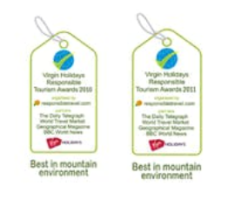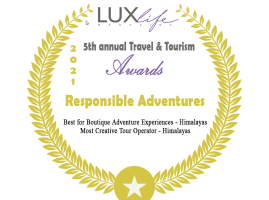Trekking in Nepal in July
In July, the monsoon season takes place. You can expect the daytime temperatures to be hot and humid below 1500 meters, warm up to 2500 meters, and warm/cool above 2500 meters. You can do most treks during July, and it is advised to choose higher altitude treks for cooler temperatures. This is an ideal time to do the Upper Dolpo Circuit, Upper Dolpo Traverse, or Upper Mustang, as these regions are in the rain shadow (you will have to book these treks with a trekking company; backpackers are not allowed into these regions).
As always – it pays to invest in the right equipment such as a suitable raincoat or even an umbrella, inner liner, a couple of layers of fleece, the right thermal underwear, thick hiking socks, gloves, trekking pants, warm hats, to name a few essential gears to invest in. It is always better to have more than less.
It is good to dress up in layers, which you can ‘peel’ one at a time when you start to warm/heat up as you begin trekking. Humidity makes it difficult for wet clothing to dry; bring a few sets to change into.
Benefits of Trekking in Nepal Himalaya during July.
This is the monsoon season, meaning many flowers and plants will bloom. However, the clouds can begin to form in the earlier part of the day, and it can start raining during the late afternoon or evening. This is a good thing as it can clear the clouds and clear the clouds for excellent mountain views the following day. In addition, there are colourful giant moths during this season.
- There will still be fewer trekkers on the trail and lodges if you go trekking during July to the popular trekking areas where there are lodges.
- You are pretty likely to be hot while hiking during the daytime.
- You might be the only trekker in the lodge.
- For the same reason, the wifi works better in the hostels as fewer people log in.
- You can use the Internet better for weather forecasts and temperatures.
- There will be fewer people queuing for hot showers.
- The flowers will be blooming at altitudes above 4500 meters.
- You can see villagers busy with agricultural activities.
- The plants, trees, and soil are fragrant with the monsoon rain.
- The sound of rain on the roof helps most people get a deep, sound sleep.
Can I do a high-altitude trek in Nepal during July?
You can undoubtedly do a high-altitude trek in Nepal during July. This is a better time to do a high-altitude trek than February or March. This is because we receive some monthly precipitation for a few days. We receive more snowfalls during February and March.
Dangers/Inconveniences of trekking in Nepal during July.
Trekking trails can be muddy and slippery. Be careful of slippery roots while trekking through forests. Leeches can be a nuisance when it is raining or in moist areas. Landslides can be dangerous; walk briskly with utmost caution when you cross landslide areas on the trail. DO NOT stop to take photos in the middle of the landslip area. Instead, two or more of you cross the landslide area while the other person looks out for falling rocks.
Leeches are a nuisance while trekking in Nepal during the monsoon. For prevention, you can make a small pouch of rock salt and chewing tobacco. First, you can dab the bag on the leeches when they get on your boots, clothes, or you. Next, you need to dip the pouch in water to moisten it; it is more efficient. Some people burn leeches or use Dettol or regular salt. However, the rain can wash them off, making rock salts and chewing tobacco mixture a preferable choice.
Thunder and Lightning storm
It is not a regular occurrence, but occasionally there might be thunder and lightning storms. So in case, you are caught in the rain:
Seek refuge in a vehicle or grounded building when lightning and thunder begin. If you are far from a car or a building, stay clear from tall objects like trees, electric/telephone poles, and bodies of water. Instead, find a depression or a low spot and make yourselves as small as possible – DO NOT lie down on the ground.
If you are a group, spread yourselves 50-100 feet away to avoid multiple victims, as lightning can travel along the ground.
If you happen to be indoors, avoid taking showers or doing laundry. Likewise, avoid charging your phone or other gadgets.
Stay indoors for at least 30 minutes after the last seen lightning or since the last thunder.
- Some lodges can be closed, but you will find a place to spend the night comfortably.
- Not all food on the menu will be available.
- Start early in the morning to avoid the afternoon rains. There usually is a pattern when it starts to rain. Study it for a couple of days or speak to the lodge owners.
- The monsoon season has started, and it can rain while you are trekking (Normally, it starts to rain from 3 pm onwards; this isn’t a hard and fast rule).
- It can continue to rain for a few days occasionally.
- The leeches start coming out in elevations below 2400 meters if it rains.
- It can be hot and humid in lower elevation areas.
- Insects in the lower altitude areas can bite you – bring suitable insecticide.
- July is the middle of monsoon; rains could disrupt domestic flights to or from Short take-off and landing strip (STOL) airports like Lukla, Jomsom, Juphal, etc. In addition, landslides can block roads causing delays in your holiday program.
July 2021 – The precipitation on the first few days of this month was heavy.
July 2020 – The beginning was slow, but the monsoon reached momentum from the middle of the month. Incessant rain took place from the 17th to the 23rd of July, and it destroyed the form of landslides and floods.
The beginning of July 2019 experienced the South West Monsoon’s delayed effects until the 6th when it finally caught up. The monsoon rains were light and patchy until the fourth week of July.
The beginning of July 2018 is receiving pretty good rainfall. However, the rain slowed down during mid-July and was reasonable to some heavy precipitation during the third and last week of this month.
Trekking regions that are in the Rainshadow areas:
















